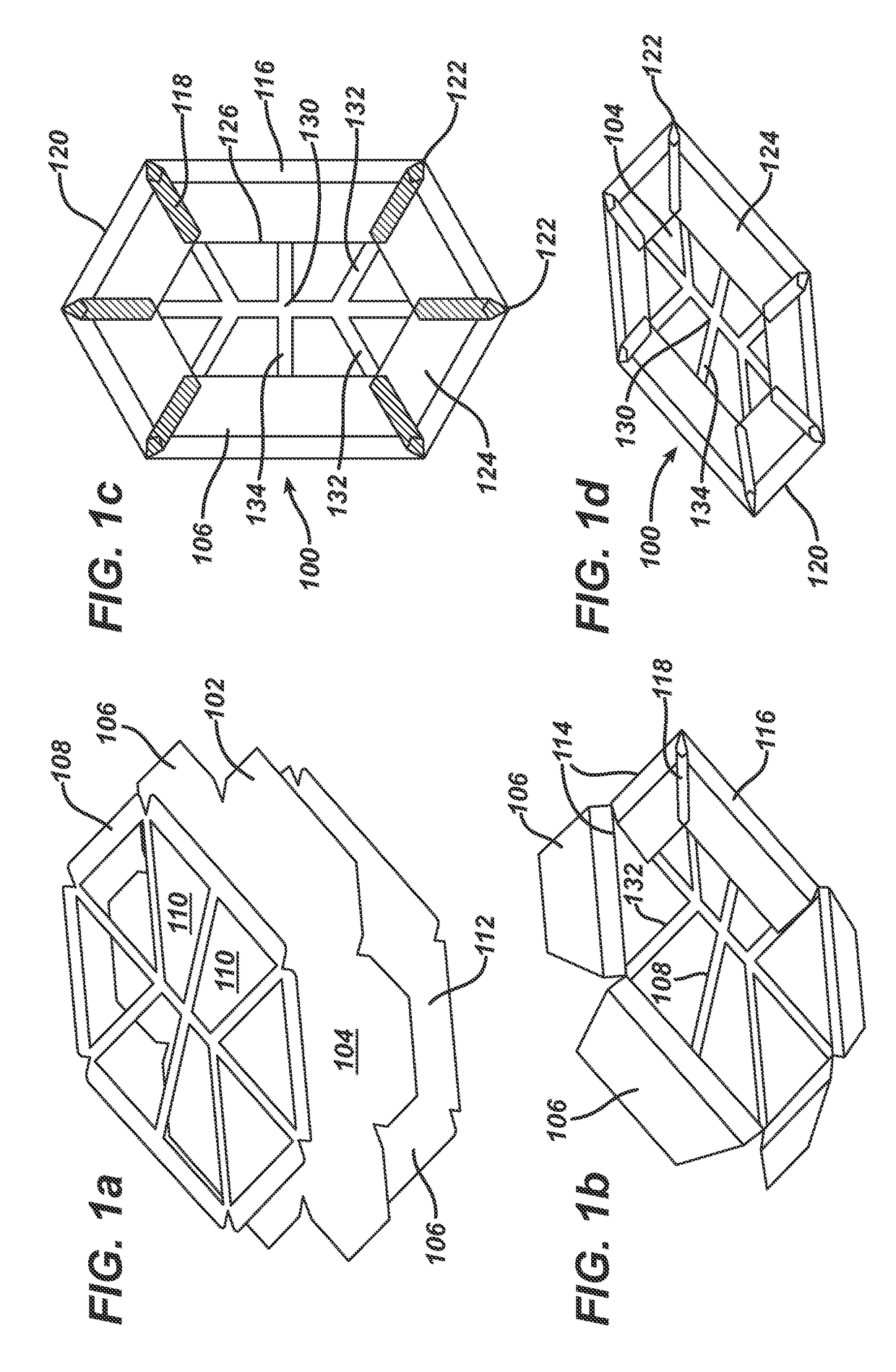Surgical implant
a surgical and implant technology, applied in the field of surgical implants, to achieve the effect of convenient surgical procedure and convenient handling
- Summary
- Abstract
- Description
- Claims
- Application Information
AI Technical Summary
Benefits of technology
Problems solved by technology
Method used
Image
Examples
first embodiment
[0041]FIG. 1 illustrates a surgical implant, which is designated by reference numeral 100, as well as a process of manufacturing the implant 100.
[0042]As shown in the explosion view of FIG. 1(a), the implant 100 is made of three parts. One part is a blank 102 consisting of a mesh-like material, in the embodiment a knitted, undyed monofilament polypropylene mesh (PROLENE™ Polypropylene Mesh of Ethicon; non-absorbable) comprising a filament thickness of 89 μm. The blank 102 defines a basic structure 104 of the implant 100 plus six flaps 106.
[0043]On top of the blank 102, FIG. 1(a) shows a marking layer 108 composed of a dyed (violet) film of poly-p-dioxanone (PDS) having a thickness of 50 μm (absorbable) and comprising a total of eight openings 110. The openings 110 can be punched or cut, e.g. by laser-cutting.
[0044]The third part visible in FIG. 1(a) is the blank of an anti-adhesive film 112. In the embodiment, the anti-adhesive film 112 is a MONOCRYL film (undyed) of 20 μm thickness...
second embodiment
[0054]the surgical implant, designated by reference numeral 200, is illustrated in FIG. 2. The implant 200 is similar to implant 100. For that reason, the parts and components of the implant 200 are not explained again in detail. In the following, only the differences between the implants 100 and 200 are pointed out. In FIG. 2, the respective associated reference numerals from FIG. 1 have been increased by 100.
[0055]Blank 202 is cut from a knitted partially absorbable mesh material made from undyed monofilaments of polypropylene (89 μm thick; PROLENE Polypropylene) and dyed (violet) monofilaments of poly-p-dioxanone (81 μm thick; PDS).
[0056]In implant 200, a center marking 230 and directional indicators 232 are not provided via a film-like marking layer, but by threads 208 of absorbable violet poly-p-dioxanone monofilaments (109 μm thick; PDS), which are sewn to blank 202 in order to form the center marking 230, six directional indicators 232, a middle line indicator 234 as well as ...
third embodiment
[0058]the surgical implant, designated by reference numeral 300, is illustrated in FIG. 3. The implant 300 is similar to implant 200. Again, the respective associated reference numerals have been increased by 100. In implant 300, the material for blank 302 and sewn marking threads 308, respectively, is the same as in implant 200.
[0059]In contrast to implant 200, anti-adhesive film 312 (again of undyed MONOCRYL film) is only 10 μm thick and is connected across its entire surface to blank 302. To achieve the latter, during the lamination process the heat is controlled to sufficiently soften or melt the PDS filaments in the blank 302 opposing the anti-adhesive film 312 and not just in the marking threads 308. In the overlap areas 318, the folded flaps 306 are fused by ultrasonic welding in a strip-like shape, as in the other embodiments.
[0060]FIG. 3(a) shows the blank 302 with the marking threads 308, FIG. 3(b) additionally the anti-adhesive film 312, FIG. 3(c) the partially finished i...
PUM
 Login to View More
Login to View More Abstract
Description
Claims
Application Information
 Login to View More
Login to View More - R&D
- Intellectual Property
- Life Sciences
- Materials
- Tech Scout
- Unparalleled Data Quality
- Higher Quality Content
- 60% Fewer Hallucinations
Browse by: Latest US Patents, China's latest patents, Technical Efficacy Thesaurus, Application Domain, Technology Topic, Popular Technical Reports.
© 2025 PatSnap. All rights reserved.Legal|Privacy policy|Modern Slavery Act Transparency Statement|Sitemap|About US| Contact US: help@patsnap.com



